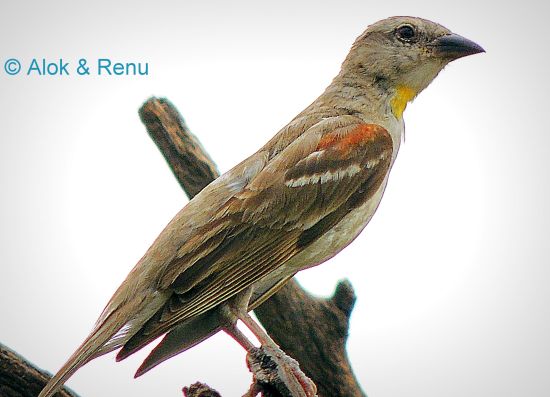Disambiguation: Yellow-throated Sparrow has been used for this species, for Yellow-spotted Bush Sparrow and for Yellow-throated Bush Sparrow.
Alternative names: Chestnut-shouldered Petronia, Chestnut-shouldered Sparrow, Chestnut-shouldered Bush-Sparrow.

Photo by Alok Tewari
Keoladeo National Park, Bharatpur, India, June-2013
- Gymnoris xanthocollis
Petronia xanthocollis
Identification
12.5 - 14cm (5-5½ in) A smallish drab sparrow with a long and slender bill
- Entirely unstreaked plumage
- Prominent white double wing-bars
- Male with chestnut shoulders
- Inconspicuous yellow throat spot
- Black bill in breeding season, pale in winter, always pale in female
Females are duller, lack the yellow throat spot and the chestnut shoulders. Juveniles have buffy wing-bars.
Similar species
Sometimes mistaken for a female House Sparrow but unstreaked and without supercilium.
Distribution
From Turkey east to Pakistan and India.
Common, locally abundant in India.
Taxonomy
In the past, this species was placed in genus Petronia.
Yellow-throated Sparrow was split from Yellow-throated Bush Sparrow and Yellow-spotted Bush Sparrow, both of which have been known under the name of Yellow-throated Sparrow.
Subspecies
Two subspecies recognized:
- G. x. transfuga in southeast Turkey, Iraq, Iran, Afghanistan and south Pakistan
- G. x. xanthocollis in east Afghanistan, north Pakistan, southern Nepal and India
Habitat
Forest and open scrub. Also in cultivated areas and villages. Occurs up to 1500m.
Behaviour
Diet
Feeds on plant material, mainly seeds. Takes also small berries and nectar, in breeding season also insects.
Forages mostly on ground. Gregarious and often seen in small groups, outside breeding season in larger flocks.
Breeding
Breeding season February to May in India. Solitary breeding or in small groups. The nest is made of grass, wool, hair and feathers. It's placed in a tree hole or in a hole in a wall or building. Takes also old nests of other species. Lays 3 - 4 eggs.
Movements

Photo by Alok Tewari
Keoladeo National Park, Bharatpur, Rajasthan India, 22 June 2017
In the north and northwest of range a partial migrant. Resident in most of India.
References
- Clements, J. F., P. C. Rasmussen, T. S. Schulenberg, M. J. Iliff, T. A. Fredericks, J. A. Gerbracht, D. Lepage, A. Spencer, S. M. Billerman, B. L. Sullivan, M. Smith, and C. L. Wood. 2024. The eBird/Clements checklist of Birds of the World: v2024. Downloaded from https://www.birds.cornell.edu/clementschecklist/download/
- Del Hoyo, J, A Elliott, and D Christie, eds. 2009. Handbook of the Birds of the World. Volume 14: Bush-shrikes to Old World Sparrows. Barcelona: Lynx Edicions. ISBN 978-8496553507
Recommended Citation
- BirdForum Opus contributors. (2025) Yellow-throated Sparrow. In: BirdForum, the forum for wild birds and birding. Retrieved 15 May 2025 from https://www.birdforum.net/opus/Yellow-throated_Sparrow
External Links
GSearch checked for 2020 platform.1





